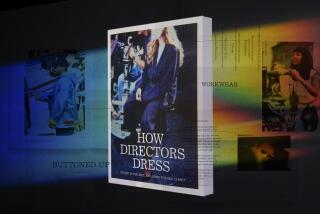John Weitz, 79; Fashion Designer, Writer Served as U.S. Agent in WWII
- Share via
John Weitz, the fashion designer with the sleek personal style of James Bond and an unconventional career that began in the Office of Strategic Services (the forerunner of the CIA), died Thursday of cancer in Bridgehampton, N.Y. He was 79.
Weitz was a savvy businessman who pioneered product licensing, put his signature on everything from business suits to ice buckets, and won a Coty Award, fashion’s top prize for style and innovation, in 1974. At the same time, Weitz was an accomplished writer of fiction and nonfiction with an expertise in Hitler’s Germany. His men’s style book, “Man in Charge: The Executive’s Guide to Grooming, Manners, and Travel,” made bestseller lists the same year Weitz won the Coty.
A slim, dashing figure who excelled at high-speed sports and moved with an international set, Weitz held memberships in at least a dozen clubs over the years, including the Vintage Sports Car Club of America and the New York Yacht Club. The air of adventure, and even danger, that surrounded him traced back to his early 20s, when he served in Army intelligence from 1943 to 1946.
He rarely talked about his experiences as an agent, not even with his family. He had signed a statement agreeing not to discuss any details before he left the military. Still, in the ‘70s, when he was at the height of his career, his friend Albert “Cubby” Broccoli, who produced the James Bond movies, saw the parallels and told Weitz he reminded him of Ian Fleming’s character.
Born Hans Werner Weitz in Berlin in 1923, he migrated to England with his parents in the early 1930s as Adolf Hitler was rising to power. Weitz’s father, Robert, was a prosperous ready-to-wear clothing manufacturer and World War I hero who had been awarded the Iron Cross.
John followed his father’s lead and went into fashion, starting as an apprentice in London with Captain Edward Molyneaux, a fashion modernist, in the late ‘30s. After the war, Weitz went to New York and designed women’s sportswear collections built on pea jackets and wraparound skirts. Ostrich feather pullovers, leather coats lined in red, and men’s striped shirts as swimsuit cover-ups caught American women’s attention.
In 1964, Weitz launched a menswear line that he personally modeled in stores. His body-contoured dress shirts were half the width of the boxy cuts that ruled men’s style at the time. Called the “European cut,” a shirt by Weitz required the wearer to maintain a washboard stomach, like his. He once declared that a wardrobe should begin with a navy blue suit. From there, however, it should spin out to turtleneck evening shirts and race flag-checked socks, preferably in aubergine and pumpkin. The look caught on among “vertically mobile” business executives.
“He was a terribly good-looking man who designed clothes for himself,” said Weitz’s son, Christopher, 32, a filmmaker in Los Angeles who made “About a Boy” and “American Pie” with his brother, Paul, 36. “My father liked sportswear for men who lived an active, dynamic life.”
The same year he launched his men’s collections, Weitz married Susan Kohner, an actress who co-starred with Lana Turner in the 1959 film, “Imitation of Life.” Bill Blass was best man at their wedding. By then, Blass had made his own mark as a rising star in New York women’s fashions.
In their Park Avenue apartment, where the staff included a Chinese chef, the Weitzes’ dinner parties brought together actors such as Yul Brynner, movie directors such as Alan J. Pakula, and writers such as Tom Wolfe, who was one of Weitz’s best friends.
By 1972, Weitz’s earnings in the U.S. alone were $18 million, stoked by licensing agreements that included housewares and home sewing patterns. He was a fashion celebrity in Japan.
His licensing business continues, but Weitz withdrew from the fashion bustle after he won the Coty. He concentrated on his writing and published seven books, including novels, and several studies of Nazi Germany under Hitler.
In recent years Weitz and his wife spent most of their time in their home in Bridgehampton, N.Y., a replica of a 1912 farmhouse. Before he died this week, Weitz asked that his ashes be scattered over Sag Harbor, near his home.
In addition to his wife, Susan Kohner Weitz, and his sons Paul and Christopher, Weitz is survived by two children from a previous marriage to Sally Gould, Karen Weitz Curtis and Robert Weitz.
More to Read
Only good movies
Get the Indie Focus newsletter, Mark Olsen's weekly guide to the world of cinema.
You may occasionally receive promotional content from the Los Angeles Times.








